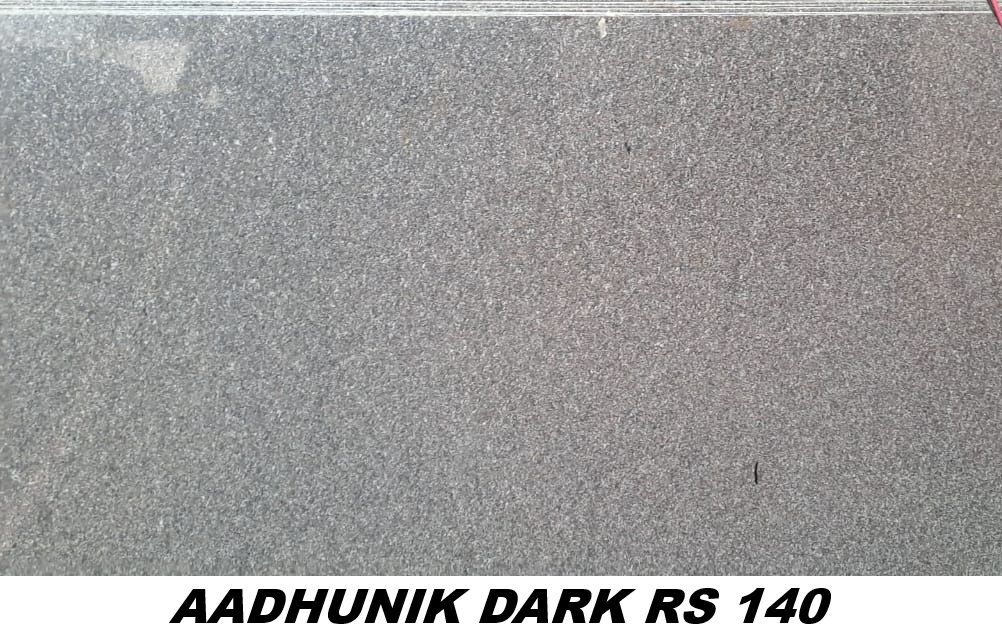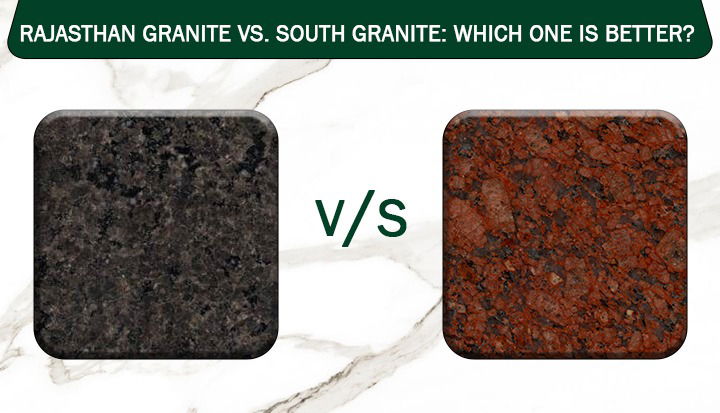Rajasthan Granite vs. South Granite: Which One is Better?


When choosing granite for your home or commercial space, two major categories dominate the Indian market: Rajasthan Granite and South Granite. Both are known for their durability, aesthetic appeal, and unique color patterns. However, differences in availability, pricing, and color varieties often make buyers wonder: Which one is better?Let’s explore the key differences between Rajasthan and South Granite to help you make an informed decision.
1. Origin and Availability
Rajasthan Granite
Rajasthan is one of India’s largest granite-producing states, offering a diverse range of granites. The state is particularly known for its desert-colored, golden, pink, and red granites, giving spaces a warm and earthy look. Popular variants include Desert Brown, Rajasthan Black, and Jaisalmer Yellow.
South Granite
South India, particularly states like Karnataka, Tamil Nadu, and Andhra Pradesh, produces some of the finest granite varieties in the world. South Granite is highly sought after for its premium quality and elegant colors, including absolute black, black galaxy, Kashmir white, and imperial red. These varieties are often preferred for luxury projects due to their high polish and durability.
2. Color and Aesthetic Appeal
How Granite Colors Impact Price
One of the biggest factors influencing granite pricing is color. Darker granites like Absolute Black from the South tend to be more expensive due to their rarity and demand. On the other hand, Rajasthan’s lighter-colored granites are often more affordable but still visually appealing.
- Rajasthan Granite Colors: More rustic, earthy tones like browns, yellows, pinks, and reds.
- South Granite Colors: Sleek and modern shades like black, white, and deep red.
If you prefer classic, luxurious colors, South Granite is the better choice. If you’re looking for cost-effective, warm, and natural tones, Rajasthan Granite is ideal.
3. Price Comparison
Rajasthan Granite Price
Rajasthan Granite is generally more affordable than South Granite due to its wider availability and lower transportation costs. Prices for common varieties range from ₹60 to ₹150 per square foot, making it a budget-friendly option for homes and commercial spaces.
South Granite Price
South Granite tends to be more expensive due to its superior quality, high polish, and limited availability in certain colors. Prices range from ₹120 to ₹400 per square foot, depending on the variety and finish.
4. Durability and Maintenance
Both Rajasthan and South Granite are highly durable and resistant to heat, scratches, and stains. However, South Granite is generally denser and less porous, making it more resistant to water absorption and stains. This makes it a better option for kitchens, bathrooms, and high-moisture areas.Rajasthan Granite, while strong, may require more frequent sealing to maintain its longevity, especially for lighter-colored varieties.
5. Cheap vs. Expensive Granite: Which One Offers More Value?
When choosing between Rajasthan and South Granite, consider your budget and project requirements:
- For Budget-Friendly Projects: Rajasthan Granite is an excellent choice due to its lower cost and warm aesthetics. It is widely available and comes in various rustic shades, making it a perfect fit for homes and commercial spaces looking for an elegant yet affordable material.
Since Rajasthan Granite is more porous than South Granite, it may require periodic sealing to maintain its beauty and longevity. However, for spaces with moderate foot traffic, this is a cost-effective and visually appealing option.
- For Premium, High-End Projects: South Granite is preferred due to its superior polish, rich colors, and durability. If you are designing a luxurious kitchen, bathroom, or commercial lobby, the sleek and modern appearance of South Granite can elevate the space’s aesthetics.
Its lower porosity makes it an excellent choice for areas exposed to moisture and spills, such as countertops and flooring in high-end residences and hotels. While South Granite comes at a premium price, the investment ensures longevity, ease of maintenance, and a timeless appeal that adds significant value to the property.Ultimately, the decision depends on your design preferences, maintenance commitment, and budget. Rajasthan Granite provides warmth and affordability, whereas South Granite delivers a refined and luxurious look for projects that require long-term durability.When selecting granite flooring, price is often the first factor homeowners consider. But does a higher price always mean better value? Let’s break it down:
| Feature | Cheap Granite (₹60 – ₹150 per sq. ft.) | Expensive Granite (₹250 – ₹600+ per sq. ft.) |
| Durability | Good, but may have more natural flaws or weaker veins | Excellent, fewer flaws, denser and stronger |
| Appearance | Simple patterns, limited color choices | Exotic patterns, rare colors, premium finishes |
| Finishes Available | Mostly polished or basic honed | Polished, honed, leathered, flamed, sandblasted |
| Maintenance | Requires regular sealing, more prone to staining | Easier to maintain, higher resistance to scratches & stains |
| Longevity | 15–20 years with care | 30+ years, often lifetime durability |
| Design Impact | Functional and budget-friendly | Luxury statement, increases property value |
| Best For | Rental properties, budget renovations, utility areas | Luxury homes, long-term investments, showcase spaces |
Tips on Selecting the Correct Granite Flooring in Your Home
The trouble is that when choosing a granite flooring, it is more than simply choosing a color that you like or fancy. It is about achieving a balance between the beauty, functionality, and value of granite floorings that in the end can be a useful long-term result.
With infinite possibilities in finishing, coloring and patterns, it is easy to feel daunted with the decision. Here are some savvy ideas to streamline the process and make sure you select the right granite in your home.
- Granite Room Purpose
Each of the rooms should have its own purpose, and the flooring must reflect that. Polished granite would especially work well in living rooms and bedrooms where its elegant look is highly desirable but in the kitchen of course, or bathroom, a honed finish or perhaps a leathered finish would be more safe, in terms of slippage.
For outdoor use, consider flamed or sandblasted granite, which provides a better grip.
- Ponder the gastronomy of colours and illumination
Colours create cheer and, sense of space. Bright-coloured granites such as white or beige do not visually shrink small rooms, whereas darker hues such as black or brown ooze a more intimate, more luxurious feel.To ensure the granite looks the same in different lights, always test the sample under natural and artificial light found in your home.
- Interior Balance Decor
Your granite interiors ought to blend with the design orientation of your house as a whole. A plain granite like Absolute Black or Crystal White may be perfect to counter heavy artificial draws in your furniture and walls.
In contrast, you can use patterned granites if you prefer your floor to be the dominant feature, such as Bianco Antico or Ubatuba.
- Consider the Maintenance
Granite is hard-wearing, though finishes will need different degrees of attention. Polished granite reflects light, but with the downside of having smudges and scratch marks; however, to avoid the above, honed or leathered texture is less demanding to users running busy lives.
Applying sealer to your granite is strongly recommended in order to prevent stains and consumption of its water.
- Vision of Long Term and Worth
Granite is a long-lasting investment. Rather than going after the latest fashion, pick a style that lasts many years and stays trendy. Neutral colors like grey and beige provide versatility, so your granite flooring can be changed even in the event you change your surroundings in the future.
- Work With Good Suppliers
Lastly, it is crucial to get granite suppliers that offer certifications and quality assurance. A good supplier not only provides a variety but also helps with the installation recommendations, so your flooring will stay in perfect shape and last longer.
Read more: Cheap vs. Expensive Granite
Case Study:
Client: A luxury hotel in Mumbai.
- Problem: Outdated marble flooring that stained easily and required frequent maintenance.
- Solution: Installed Galaxy Black and Viscount White granite in lobby and corridors, ensuring a modern yet timeless look with high durability.
- Impact: Reduced maintenance costs by 35%, improved guest satisfaction scores, and elevated the hotel’s overall aesthetic appeal.
Customer Experiences
Partnering with Quality Marble India has been a game-changer for our projects. Their range of premium granite options, timely deliveries, and expert guidance have helped us complete high-end residential and commercial spaces with unmatched quality. The durability of their granite ensures our clients keep coming back to us for future projects.
Which One Should You Choose?
Both Rajasthan and South Granite have their unique advantages. If you’re looking for affordable, earthy-toned granite, Rajasthan Granite is the best bet. However, if you prefer premium, polished finishes and rich colors, South Granite is the winner. Looking for high-quality granite for your next project? Contact Quality Marble India for expert guidance and a wide selection of Rajasthan and South Granites at competitive prices!Understanding Granite Grades: How to Spot the Differences in 2025Understanding Granite Grades: How to Spot the Differences in 2025